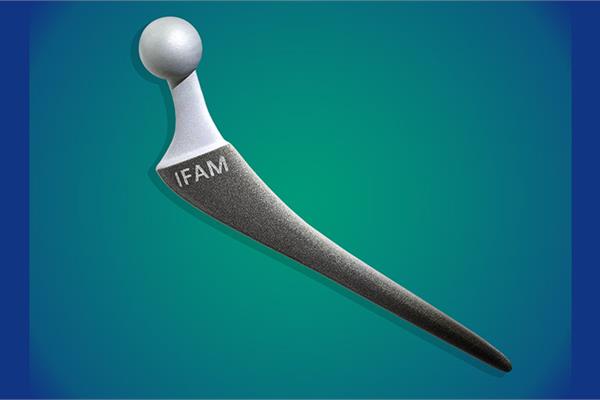
A team of researchers has developed a hybrid implant coating made from antibacterial silver and an antibiotic, which offers to the patients protection from future infections.
Researchers from the Fraunhofer Institute for Manufacturing Technology and Advanced Materials IFAM have developed a hybrid coating consisting of antibacterial silver and an antibiotic that can protect the patients who have an implant from the risk of infections. The antibiotic is tailored to the patient's unique requirements for even a better protection.
The idea, now part of the AntiSelectInfekt project, was developed four years ago at the Fraunhofer Institute for Manufacturing Technology and Advanced Materials IFAM in Bremen.
"Surface treatment is one of the areas our institute specializes in. Applying this expertise to medicine was a natural choice", says Kai Borcherding, Head of Medical Technology and Life Sciences at Fraunhofer IFAM.
Why reducing the risk of infections is a pivotal matter
Despite the cutting-edge technologies and medicine, implantation of artificial knee, shoulder or hip is not without risk.
On average, 1% to 2% of all patients will develop an infection following the operation. If the level of discomfort is so severe that another surgery is necessary, an infection can be expected in up to 4% of all cases, declares Fraunhofer.
Even if the individual risk is in the lower percentage range, it affects many patients due to the frequency of the surgery. In view of demographic developments, the number of prosthesis operations will also increase steadily.
If the antibiotics administered do not help, it could be a long and painful process or the implant will have to be replaced.
This new approach promises to significantly reduce the risk of infection, declares Fraunhofer.
The AntiSelectInfekt project
Fraunhofer researchers further developed, tested and implemented the idea of this hybrid coating through the AntiSelectInfekt project in collaboration with researchers of the Julius Wolff Institute and the BIH Center for Regenerative Therapies (BCRT) of Charité in Berlin. The results are promising.
"The preclinical studies have demonstrated that the hybrid implant coating effectively reduces the rate of infection," explains Prof. Britt Wildemann, who is in charge of the studies on effectiveness and biocompatibility in Berlin and is now Head of Experimental Trauma Surgery at Jena University Hospital.
While the idea of coating implants is not new - as the ability of silver and antibiotics to combat infections associated with implants has long been studied - the novelty relies in the approach of combining the two and thus improving active protection against bacteria.
Another benefit comes from the fact that researchers have developed a process that allows them to use an antibiotic tailored to the patient's requirements.
The special coating technology developed by Fraunhofer IFAM also regulates release of the antimicrobial substances: while the antibiotic is released in full once the implant is in place, the silver particles take effect gradually close to the surface over a longer period of time, thus providing lasting protection that continues into the healing phase.
The coating process and how the technology works
The coating process is based on tried-and-true technologies further developed specifically for the project.
"The first step is to apply a structure to the surface of the titanium implant using a laser. This creates a porous layer," explains Borcherding. "Tiny pores that are mere micrometres in size and invisible to the naked eye appear on the titanium surface. These pores are amphora-shaped, meaning they are narrower above and wider below. In the second step, researchers use the process of physical vapor deposition to apply a layer containing silver particles".
These amphora-shaped pores can be filled during the surgery: just before implantation, the surgeon immerses the sterile implant with silver coating in a solution containing the antibiotic.
"We have seen in preclinical studies that the entire process is very simple and only takes a few minutes," says Prof. Wildemann. "Once the implant has been implanted, whether it is a hip, knee or shoulder joint, the antibiotic begins releasing into the surrounding tissue, promptly killing off any bacteria that could cause an infection. The effect of the silver coating is delayed and lasts much longer. The silver ions remain active for several weeks and offer protection from infection during the healing phase".
The development process
Biocompatibility and osseointegration, which refers to the anchoring of an implant through the formation of new bone, were studied
both in lab tests with human bone cells and in the animal model. "One of the challenges during the development phase was ensuring the concentration of antibiotic was high enough to kill bacteria, but not so high that it would damage the growing bone cells," explains Borcherding.
The pores applied to the titanium surface with the laser treatment also ensure better bone adherence.
"Our study has shown that surface modification increases bone contact: 89% contact with implants featuring the hybrid coating, compared to just 52% bone contact in the control group. We were also able to prove that cells grow into the amphora-shaped pores and thus anchor the implant much more effectively", explains Prof. Wildemann.
The project has already met with great interest among implant manufacturers and providers of coating services, particularly because no new implants need to be developed for the process, as products that are already available can be coated.
Discussions with manufacturers are being intensified in the final stage of the project to ensure the technology can be used for patients in the near future.